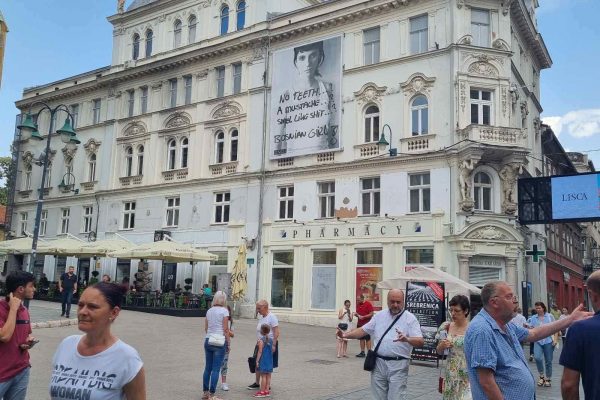Gallery 11/07/95 commemorated the 26th anniversary of the Srebrenica genocide and the ninth anniversary of its work, focusing on the attitude and perception of the international community towards the war in Bosnia and Herzegovina and the Srebrenica genocide. In July 1995, in merely a couple of days, over 8,000 people were killed simply because of their different names, religion, and ethnicity. The organisers and perpetrators of the crimes are known. Only a few weeks ago, Ratko Mladić, the commander-in-chief of the Republika Srpska Army, was sentenced to life in prison. One of the points on which he was convicted was the genocide in Srebrenica. The families of the victims of genocide are still searching for the remains of their loved ones, and the genocide and trauma of genocide remain a part of a permanent record for the generations that came after the genocide and those that are yet to come.
However, apart from the position of the victims and perpetrators, the story of the Srebrenica genocide, its historical construction, memory, and remembrance of the genocide are defined by yet another perspective. It is about the perspective of the observer, the one before whose eyes the crimes took place, but also the one, who enabled genocide by averting his eyes, exhibiting indifference, prejudice, exclusion, and lack of empathy.
Photographs of graffiti written by UN soldiers during their mandate in Srebrenica are part of the Gallery’s permanent exhibition 11/07/95. Troops of the Royal Dutch Army were responsible for the security of the Srebrenica Protected Zone from 1993 to 1995 as part of their work as part of UNPROFOR (United Nations Peacekeeping Force).
Photos of the graffiti were recorded, shortly after the war, by Tarik Samarah. They form an integral part of his artistic story about Srebrenica, which is the basis of the permanent exhibition of the Gallery 11/07/95.
Graffiti written by UN soldiers on the walls of the compound in which they were stationed reveal the prejudices, misconceptions, and dehumanisation of the local population. Diversion, inability to empathise, and misunderstanding the victim’s position are part of the narrative that determined the fate of the Srebrenica victims.
Tarik Samarah, photographer and director of Gallery 11/07/95, said the following about the importance of graffiti: “Graffiti written by UN soldiers on the walls of a former battery factory in Potočari are an illustrative metaphor for the indifference of the international community towards Bosnian Muslims during the 1990s. They are a kind of document and the statement of prejudice, indifference, and lack of empathy. Photographs of graffiti are an integral part of my photographic story of Srebrenica because, in addition to those who committed crimes in Srebrenica, there were those who could have prevented the genocide, but they did not”.
The hesitation of the international community to prevent the genocide in Srebrenica, but also the war in Bosnia and Herzegovina, is rooted, among other things, in the prejudices recorded on these graffiti. “Focusing on the graffiti of Dutch soldiers, this year we want to ask whether the fate of Srebrenica would have been different if the prejudices were not so strong, but also to call for understanding and empathy as the only way to prevent new crimes”.
As part of this year’s theme of the 26th anniversary of the Srebrenica genocide, Gallery 11/07/95 is exhibiting the work “Bosnian Girl” by Bosnian artist Šejla Kamerić. The work was created in 2003 and is a portrait of an artist over which insulting messages of one of the graffiti of UN soldiers was written. The work is exhibited on the facade of the building in which Gallery 11/07/95 is located, and the aim of the exhibition is to thematise prejudice as a discriminatory practice that leads to crime.
Šejla Kamerić, the author of the conceptual work “Bosnian Girl” stated the following: “We live in a constant war in which women’s bodies are viewed as territory. The Bosnian girl is not me, but any girl or woman… anyone whose rights are denied. This work comes from Bosnia and Herzegovina, but it tells a universal story of hatred and prejudice”. In addition to exhibiting the work “Bosnian Girl”, and with its permanent exhibition partially dedicated to the role of the international community and international public in the genocide in Srebrenica, Gallery 11/07/95 created a campaign on social networks through which, using photos of graffiti and accompanying text, illuminates the role of “neutral” observer from a new perspective. On July 12th, 2021, Gallery 11/07/95 marked the ninth anniversary of its work, and this date was symbolically chosen as the day when the remembrance of the victims of Srebrenica begins. By presenting the work “Bosnian Girl”, Gallery 11/07/95 continues its activities of building a continuous culture of memory, believing that culture and art as practices can have transformative and healing power for society and community at large.
